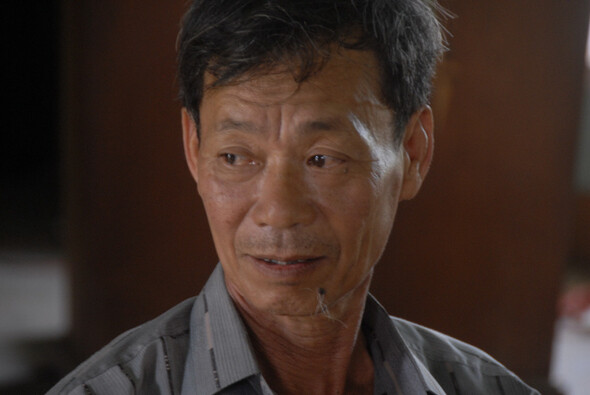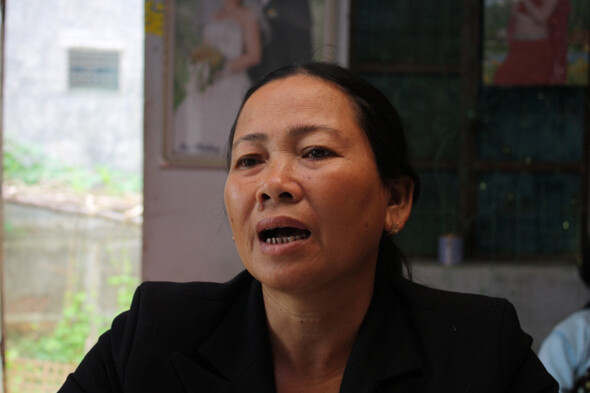hankyoreh
Links to other country sites 다른 나라 사이트 링크
Vietnam War massacre survivors making their first visit to South Korea

Two survivors of civilian massacres in South Korean troop regions during the Vietnam War are coming to South Korea.
The visit was announced on Mar. 28 by the Peace Museum, a foundation chaired by Lee Hae-dong.
“For the 70th anniversary of South Korean independence and the 40th anniversary of the end of the Vietnam War, we have invited the war victims Nguyen Tan Lan, 64, and Nguyen Thi Thanh, 55, and Ho Chi Minh City War Remnants Museum director Huynh Ngoc Van, 53, to attend the Lee Jae-gap photography exhibition ‘One War, Two Memories,’ which begins on Apr. 7,” the museum explained in a press release.
The visitors are scheduled to arrive at Incheon International Airport on Apr. 4. After a visit to the Sharing House Museum of Sexual Slavery by the Japanese Military in Gwangju, Gyeonggi Province, on their first day, they are to spend the week visiting the National Assembly and attending invitational round table discussions in Seoul, Busan, and Daegu.
The visit would be the first to South Korea by survivors of civilian massacres in regions where the country’s troops were stationed during the Vietnam War. It comes 50 years after the South Korean military sent its first combat troops to Vietnam in October 1965, and 40 years after the war ended with South Vietnam’s defeat and the fall of Saigon on Apr. 30, 1975.

Nguyen Tan Lan is visiting from An Binh in Tay Vinh (formerly Binh An), a village in Binh Dinh Province near the “Tiger” division (now known as the Capital Mechanized Infantry Div.) site where 65 residents were killed on Feb. 15, 1966. Nguyen Thi Thanh’s village in the Phong Nhi/Phong Nhat area of Dien Ban District, Quangnam Province, was located near the “Blue Dragon” division (now known as the Second Marine Div.) site where 74 people were killed on Feb. 12, 1968.
Nguyen Tan Lan lost a mother and younger sister during a search of houses by Tiger division members and suffered grenade fragment wounds in his lower body that have caused lifelong pain. In 2003, he underwent surgery to remove the fragments with the help of Medics for Vietnam and Peace, a South Korean medical care group.
Nguyen Thi Thanh lost five family members when her mother, older sister, younger brother, aunt, and cousin were killed by Blue Dragon division members in her village. Her older brother was maimed, while Nguyen herself suffered a severe gunshot wound to her abdomen that left her entrails protruding from her body - an injury that required a year of hospital treatment.
In a statement prepared in advance of the visit, the two lifelong victims of painful memories and trauma said the “sounds of the massacre live on in our minds, the memories of the brutal massacre and the tortured screaming.”
“We hope that our visit will result in a deep discussion of the Vietnam War in South Korea,” they added.
War Remnants Museum director Huynh Ngoc Van, who is accompanying them on their visit, plans to visit the National Assembly on the afternoon of Apr. 6 before delivering a speech titled “South Korea-Vietnam goodwill forty years after the war” at the parliament’s press center.
Secretary-general Seok Mi-hwa of the Peace Museum, which planned the invitation, said the first visit by survivors of massacres by South Korean troops during the Vietnam War “was intended as a way for civil society to shed new light on the painful memories between the two countries forty years after the war.”
“It‘s comparable to the first Tokyo visit by comfort women survivors in 1992,” Seok added.
A total of 320,000 South Korean troops were sent to Vietnam during the war years of 1965 to 1973. Previously, only the killing of 50,000 enemy troops, including North Vietnamese soldiers and guerrillas with the National Liberation Front (Viet Cong), was reported, along with 5,000 deaths on the South Korean side.
The figures have since become the topic of questions and controversy, with allegations of over 9,000 deaths in civilian massacres since the current affairs weekly Hankyoreh 21 first printed a Sept. 1999 interview with victims from five central Vietnamese provinces where South Korean troops operated.
A Hankyoreh 21 investigation and 1980s figures from the Vietnamese politburo’s war crimes investigation commission calculated the number of civilians killed by the Tiger division near Nguyen Tan Lan’s home village of Tay Vinh at 1,004 between January and February 1966, with another 357 killed by the Blue Dragon division in Nguyen Thi Thanh’s home district of Dien Ban between January and February 1968.
By Koh Kyoung-tae, staff reporter
Please direct questions or comments to [english@hani.co.kr]

Editorial・opinion
![[Guest essay] The real reason Korea’s new right wants to dub Rhee a founding father [Guest essay] The real reason Korea’s new right wants to dub Rhee a founding father](https://flexible.img.hani.co.kr/flexible/normal/500/300/imgdb/original/2024/0423/8317138574257878.jpg) [Guest essay] The real reason Korea’s new right wants to dub Rhee a founding father
[Guest essay] The real reason Korea’s new right wants to dub Rhee a founding father![[Column] ‘Choson’: Is it time we start referring to N. Korea in its own terms? [Column] ‘Choson’: Is it time we start referring to N. Korea in its own terms?](https://flexible.img.hani.co.kr/flexible/normal/500/300/imgdb/original/2024/0423/3617138579390322.jpg) [Column] ‘Choson’: Is it time we start referring to N. Korea in its own terms?
[Column] ‘Choson’: Is it time we start referring to N. Korea in its own terms?- [Editorial] Japan’s rewriting of history with Korea has gone too far
- [Column] The president’s questionable capacity for dialogue
- [Column] Are chaebol firms just pizza pies for families to divvy up as they please?
- [Column] Has Korea, too, crossed the Rubicon on China?
- [Correspondent’s column] In Japan’s alliance with US, echoes of its past alliances with UK
- [Editorial] Does Yoon think the Korean public is wrong?
- [Editorial] As it bolsters its alliance with US, Japan must be accountable for past
- [Guest essay] Amending the Constitution is Yoon’s key to leaving office in public’s good graces
Most viewed articles
- 1[Guest essay] The real reason Korea’s new right wants to dub Rhee a founding father
- 2Why Korea shouldn’t welcome Japan’s newly beefed up defense cooperation with US
- 3Terry Anderson, AP reporter who informed world of massacre in Gwangju, dies at 76
- 4[Column] ‘Choson’: Is it time we start referring to N. Korea in its own terms?
- 5[Column] The clock is ticking for Korea’s first lady
- 6Opposition calls Yoon’s chief of staff appointment a ‘slap in the face’
- 7Senior doctors cut hours, prepare to resign as government refuses to scrap medical reform plan
- 8New AI-based translation tools make their way into everyday life in Korea
- 9[Editorial] Japan’s rewriting of history with Korea has gone too far
- 10[Column] Are chaebol firms just pizza pies for families to divvy up as they please?